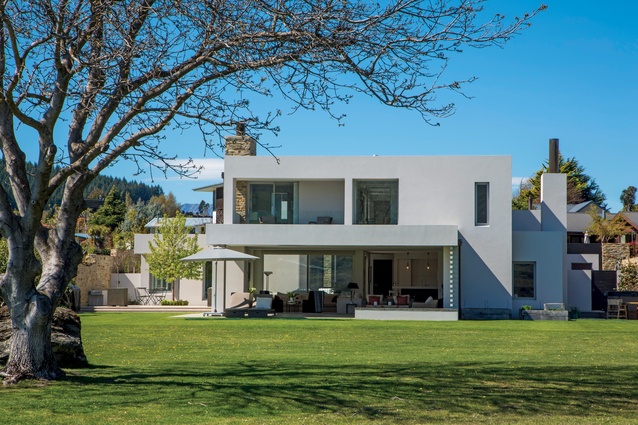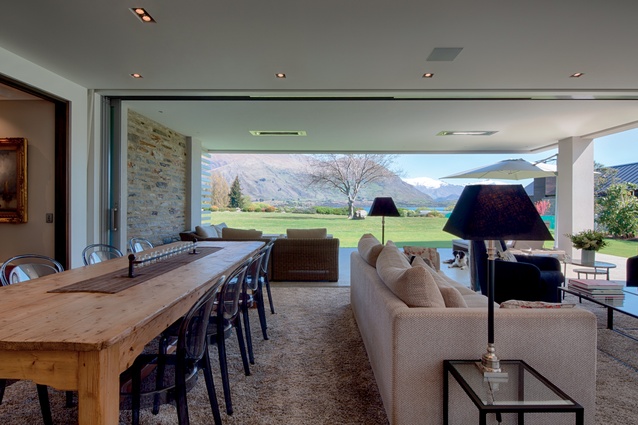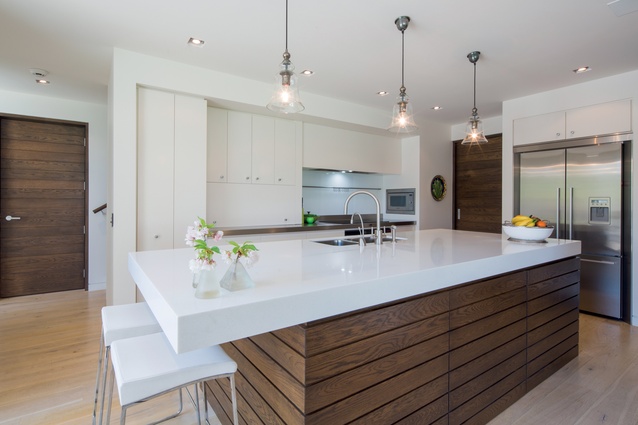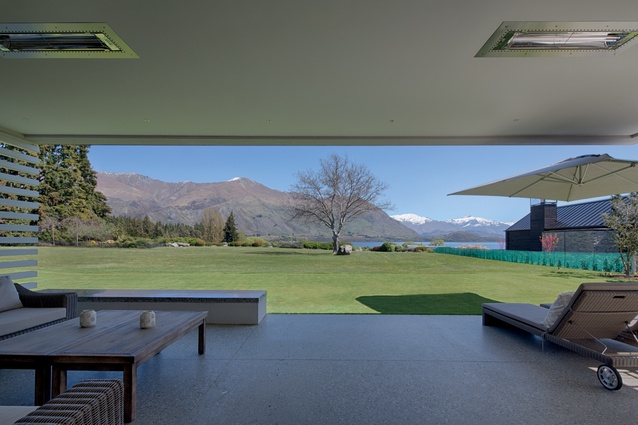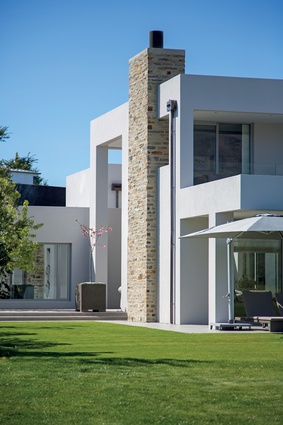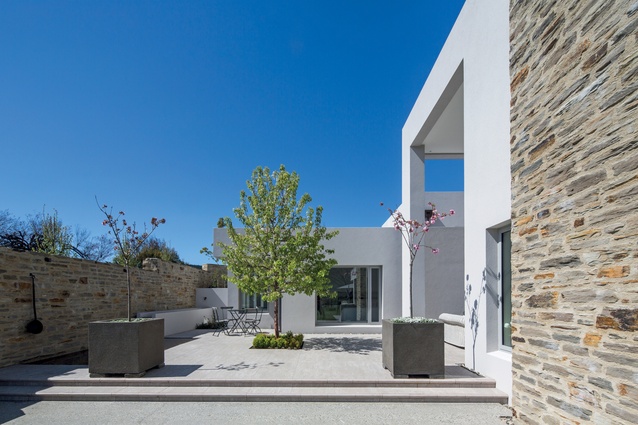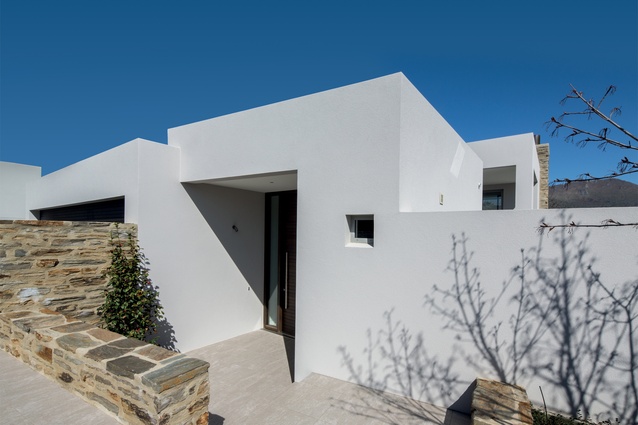Houses revisited: Wanaka house
A modernist home makes a statement in Wānaka, where its bold geometry of clean, white lines contrasts with the local vernacular of pitched ceilings and predominance of schist. First published in 2015.
Rather, this house demonstrates a subtle and pared-back use of local materials while a simplistic modulation of form complements the surroundings by offsetting them. The 380m2 holiday house is set within a six-lot subdivision with extensive views of Lake Wānaka and the surrounding mountains to the west. While an enviable site, it brought its own challenges with it, including a strict covenant: a defined building platform and a panoramic orientation that faces an intensely hot, setting summer sun.
Architect Richard Shackleton’s response is a two-storeyed, split-level arrangement built to mitigate summer’s solar gain and maximise winter sun orientation, and to utilise the opportunity for uninterrupted access to awe-inspiring lake and mountain views. However, it is still private, with the garage and entry at mid-level the only visible face from the street.

The hero is the main living area, which features a nine-metre-wide retracting glass wall that pulls back to connect the inside to the outside. A series of vertical slats protruding from the western wall emphasises this connection, drawing your eye toward the landscape. An extensive roof overhang to west elevations delays intrusion of the late summer sun.

Where one space is open to the elements, other spaces are more intimate. A winter room, located adjacent to the open-plan living area and featuring a wood-burning fireplace, provides an intimate retreat during the colder winter months, yet can also be used as an escape from the heat in summer.
The exterior, too, is to be celebrated. Shifting and strong geometry characterises the form, as angles reveal cut-aways and vertical and horizontal shafts alternate between letting in and obscuring light at opportune moments and in appropriate locations.
“The sharp edges of this home are strongly articulated against the intensity of the area, from the blue sky to the backdrop of lake and mountains,” says Shackleton. “Spaces overlap and interweave to create vistas and view paths on a macro and micro scale. These are conscious gestures to grab the light.”
And while it is a response to the environment and the clients, it is borne of a preferred style.
“This modernist style makes sense from an aesthetic, thermal and cost perspective as well,” adds Shackleton. “For me, it is also about creating a spatially interesting form that is clean, pure and free from fuss and lots of different materials.
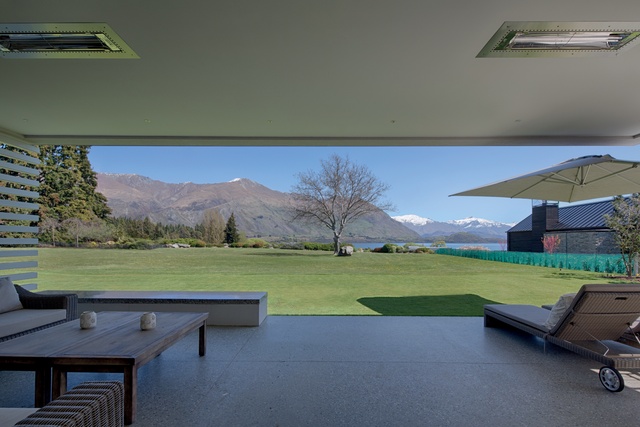
“Materials such as stone — which are explored inside and as cladding in this home — are used strategically, as I believe it loses some of its magic when used en masse.”
Indeed, this home is an assemblage of spaces that expresses a powerful exterior silhouette without compromising demands to capture views and light and to mitigate the extreme effects of cold winters and hot, dry summers. The point of intersection of these intentions culminates in a strong form, submissive only to the more powerful colours and contrasts of the natural environment.

What is the StoTherm Masonry Insulation System? It’s an exterior insulating and finishing system for concrete masonry. In this case we have used Sto render on 80mm polystyrene panels over concrete blockwork with a render finish. The interior surfaces are strapped and lined. Because the system has been designed with minimal thermal conductivity and no thermal bridging, it helps reduce energy consumption while protecting the building substrate.
What is the advantage compared to traditional interior insulation? The thermal mass of the masonry is taken full advantage of while creating an external dew point over an internal one, which helps to combat condensation and mould. When temperatures change quickly and extremely, as they do in this climate, the thermal environment of the house takes longer to react and is more stable, almost unchanged. Only approved applicators can install it, so that brings with it a certain standard also.
How does it compare to other systems? For me, it has been intuitive to use this product because it combines render and insulation, and a finish paint that is integral to the system. The system is relatively expensive. However, the additional benefits and attributes of the system need to be factored in when making your choice of insulation.
Click here to see more Houses Revisited. And sign up to our email newsletters to receive Houses Revisited straight to your inbox.
Note: These are stories from our archives and, since the time of writing, some details may have changed including names, personnel of specific firms, registration status, etc.

